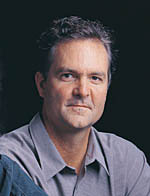May 1, 2006
UCSC Professors Haussler and Woosley elected
to National Academy of Sciences
By Tim Stephens
Two UCSC faculty members were elected to the National Academy
of Sciences on Tuesday, April 25, in recognition of their distinguished
and continuing achievements in original research. David Haussler,
professor of biomolecular engineering, and Stan Woosley, professor
of astronomy and astrophysics, are among 72 new members of the
academy elected this year.

David Haussler (above) and Stan
Woosley are among 72 new members of the National Academy
of Sciences.
|

|
"Election to the academy is considered one of the highest
honors in American science and engineering," said Ralph
Cicerone, who became president of the academy in 2005.
For Haussler, his election to the National Academy of Sciences
came a day after the announcement that he has also been elected
to the American Academy of Arts and Sciences (see separate
story). Woosley is also a fellow of the American Academy
of Arts and Sciences, an honor he received in 2001.
Haussler, a Howard Hughes Medical Institute Investigator, directs
the Center for Biomolecular Science and Engineering at UCSC.
He is also affiliated with UCSC's Center for Molecular Biology
of RNA and is scientific codirector of the California Institute
for Quantitative Biomedical Research. He has done pioneering
work in the fields of computational learning theory and bioinformatics.
His research group made vital contributions to the International
Human Genome Project and remains at the forefront of the field
of computational genomics, exploring the evolution and function
of human genes and working to identify and understand all of
the biologically important parts of the genome.
A fellow of the American Association for the Advancement of
Science and the American Association for Artificial Intelligence,
Haussler earned his B.A. in mathematics from Connecticut College,
M.S. in applied mathematics from California Polytechnic State
University at San Luis Obispo, and Ph.D. in computer science
from the University of Colorado at Boulder. He joined the UCSC
faculty in 1986.
Woosley, a theoretical astrophysicist, is a leading authority
on supernovae and gamma-ray bursts, the most violent explosions
in the universe. He directs the Center for Supernova Research,
funded by the Department of Energy and headquartered at UCSC.
His work on the evolution of massive stars and their explosion
as supernovae describes how the "heavy" elements needed
for life, such as oxygen and iron, are forged and ejected. In
addition, Woosley's "collapsar" model of massive star
explosions has been identified as the central engine of certain
types of gamma-ray bursts in which a huge dying star collapses
into a central black hole.
A fellow of the American Physical Society (APS), Woosley received
the APS's Hans Bethe Prize, as well as the American Astronomical
Society's Bruno Rossi Prize, in 2005. UCSC's Division of Physical
and Biological Sciences honored him with its Outstanding Faculty
Award in 2003-04. Woosley earned his B.A. in physics and M.S.
and Ph.D. in astrophysics from Rice University. He joined the
UCSC faculty in 1975 and has served three times as chair of
the Department of Astronomy and Astrophysics.
The National Academy of Sciences is a private organization
of scientists and engineers dedicated to the furtherance of
science and its use for the general welfare. It was established
in 1863 by a congressional act of incorporation signed by Abraham
Lincoln that calls on the academy to act as an official adviser
to the federal government, upon request, in any matter of science
or technology.